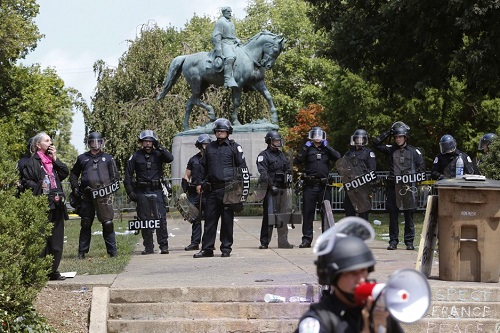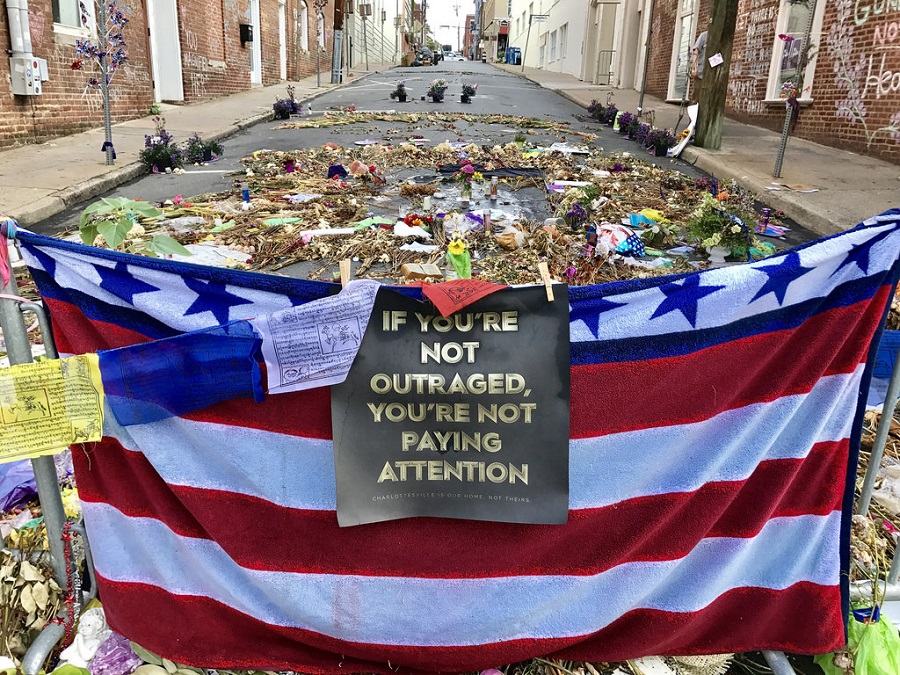AP photo
By
Robert Boucheron
Charlottesville is a courthouse town, a place of gardens and neoclassical architecture, red brick and white trim, oak trees and boxwood. It has a public university of national rank and a hero in the original Greek sense, Thomas Jefferson. Born and raised here, Jefferson designed and built his highly original home, Monticello, on a mountain to the east.
Thirty years ago I escaped here from New York. I admired the town, and I wanted to love the people. My first job was for an architect named Henderson Heyward, an old gentleman who regaled his staff with stories of ancestors who owned plantations of so many acres and so many slaves. He and other educated whites had charming manners and a seductive drawl. But they told jokes about “niggers.”
Then there were attitudes to the Civil War. In conversation, people objected to the phrase: it was the War of Secession or the War of Northern Aggression. I attended Christ Episcopal Church and stared at stained glass windows made in memory of officers whose names ended in “C. S. A.” A standing Confederate soldier watched over a cannon and pyramid of cannonballs in front of the county courthouse. A few yards away was a bronze equestrian statue of Thomas Jonathan “Stonewall” Jackson, a Confederate general and hero of the Shenandoah Valley. Two blocks to the west was a small city park named for General Robert E. Lee, with a bronze equestrian statue of Lee in the center.
As a Yankee, I was convinced that the North had won. “Confederate” was almost a synonym for “counterfeit.” Why did these people persist in remembering defeat? Thirty years on, after visiting places like Appomattox, reading about the war, and listening to the oral tradition, I understand a little. Virginia took a leading role. It suffered physical destruction and loss of lives. Then came the long, sad aftermath of racial segregation, Jim Crow, and the revisionist history of the “Lost Cause.” Battle reenactments and Confederate flags appeared as a reaction to the civil rights movement of the 1950s.
For a local newspaper, I wrote about the remarkable set of five bronze sculptures in the city. In addition to the Confederate soldier and Generals Jackson and Lee, there is a group of the Louisiana Territory explorers William Clark and Meriwether Lewis with their guide Sacagawea, and another group titled “George Rogers Clark, Conqueror of the Northwest.” The Clark family lived nearby in Albemarle County. Except for the soldier, which was mass-produced, the statues are works of art by American sculptors, mounted on carved granite pedestals. A local benefactor named Paul Goodloe McIntire gave the four bronze sculptures to the city from 1919 to1924. He also gave the land which became Lee Park, a public library, and other gifts to the city and to the University of Virginia.
McIntire’s gifts were part of the City Beautiful movement in North America. From the 1880s to the 1920s, private groups and urban planners created parks, civic centers, and monumental spaces adorned with statues. The style was neoclassic and French, as taught at the École des Beaux Arts in Paris. The World’s Columbian Exposition of 1893 in Chicago was a landmark of the movement. Called the “White City” for its plaster architecture, the fair celebrated European culture in America, a theme that was “white” in another sense. Monument Avenue in Richmond, Virginia, developed from 1890 onward, is a five-mile set piece of urban design that includes several Confederate statues. New Orleans erected four monuments in the same spirit. Their removal this year led to a call to remove the statues of Jackson and Lee in Charlottesville, a call which led to the tragedy of August 12.
Heather Heyer memorial – Joe Flood photo
I did not attend the rally and protest, but I saw and heard the helicopter from my house. It proved to be both useless and fatal to the two men inside it. For weeks after, Fourth Street was closed. Memorials of flowers, photographs, and notes marked the spot where Heather Heyer died. The pedestrian zone called the Downtown Mall swarmed with reporters. Comments by the governor and other state leaders were guarded, but they echoed what I heard from my neighbors. The city mayor and police had bungled the affair, and the state police had made it worse. Why did the city grant a permit? Why did the police deployed on the ground do so little to prevent violence?
Virginia has an “open carry” law, which means that a licensed person can openly carry firearms, even in a crowded urban space. The video footage of right wing paramilitary guys waving guns in the city streets was scary. It was also absurd, a kind of theater, but the drama ended in real death.
Lee and Jackson are now shrouded in black. The city government says the statues will be sold and removed. Since the statues are now lightning rods for white supremacists, they have to go, but a state law prevents the city from acting. I hear a wish that things could return to the way they used to be, and a sentiment that outside agitators are to blame—echoes of fifty years ago. The Confederate soldier gets a reprieve. A memorial to local men who died, he stands all over the South. Descendants will object to taking him down.
The comment I hear most often is that the statues are part of history, which should not be erased. True enough, but the history is slanted and incomplete. Monticello, like other historic sites in the South, is now doing what it can to document the presence of black residents and their contributions. Their unpaid labor built so much of what we admire today. But blacks are staying out of the current conversation. “You all made this mess,” one said. “You fix it.”
A century ago, the choice of political and military figures from the recent past as subjects for public art must have seemed natural. But who else might have been chosen? Jefferson already stood in marble and bronze at his university. Presidents George Washington, James Madison, James Monroe, and Zachary Taylor were all Virginians, and all but Washington had local ties. A historic figure like Jack Jouett, who rode like Paul Revere to warn that the British were coming, would have been appropriate. Another is Dr. Thomas Walker, who explored southwest Virginia and helped to create the city of Charlottesville in 1763.
Suggestions have come forward to replace the Confederate statues with monuments to people of color, civil rights leaders, and important women. “History” reflects the power of interest groups, and it shifts as they do. Jouett and Walker as white males may not suit the moment. Paul Goodloe McIntire, who made his money trading stocks in Chicago and New York, also suffers a disability. Martha Jefferson, wife of Thomas, has a hospital named for her. York, a black man who accompanied Lewis and Clark, has a building on the Downtown Mall.
I would like to nominate Sally Hemings, a mixed-race slave who served as Jefferson’s second, unacknowledged wife and bore him six children. As enigmatic as her famous consort, Hemings decided to stay with him, when she might have claimed her freedom in Paris. Her free descendants kept her memory alive. Her statue erected in a public space would challenge us all.
Robert Boucheron
Robert Boucheron grew up in Syracuse and Schenectady, New York. He worked as an architect in New York City and Charlottesville, Virginia. His short stories and essays appear in Fiction International, Fictive Dream, Litro, New Haven Review, Porridge, Poydras Review, Short Fiction, and other magazines.




No Comments Yet!
You can be first to comment this post!